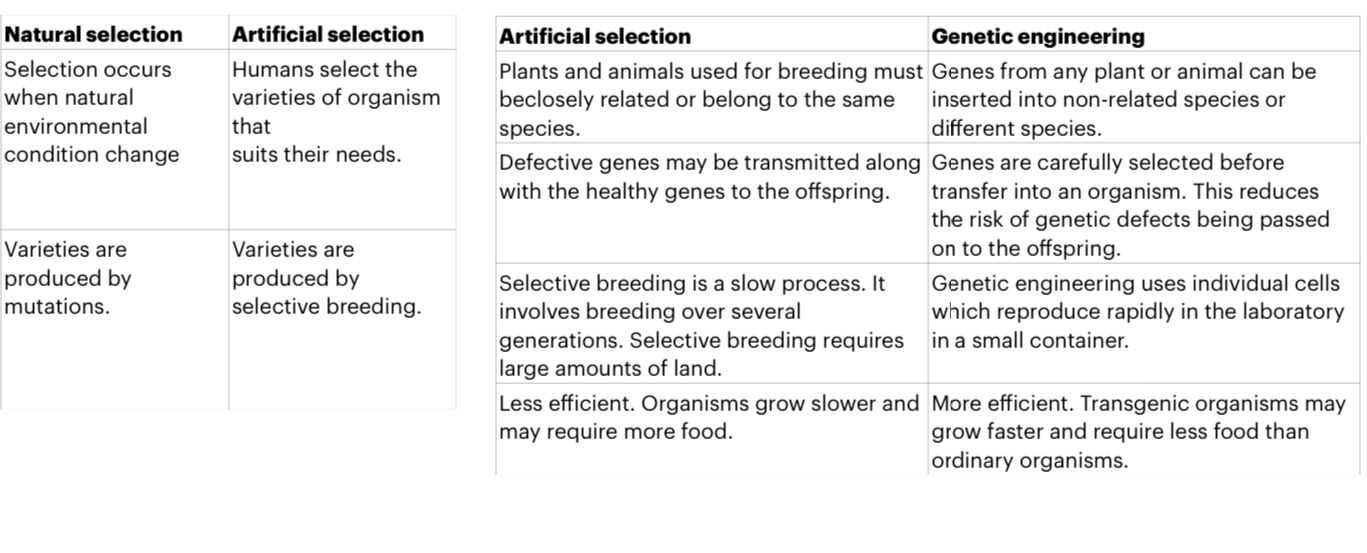Chapter 22 - Inheritance
Mendel’s monohybrid crosses
A %%monohybrid cross%% begins with:
(a) %%Cross-pollination%% between true-breeding parents (P generation)
(b) P generation produces %%hybrid offspring%%(offspring from 2 different varieties), called the %%F1 generation%%.
(c) F1 hybrids %%self-pollinate%% to produce another set of offspring, called the %%F2 generation%%.
One of Mendel’s monohybrid crosses:
(a) P generation consisted of true-breeding plants producing either purple or white flowers.
(b) F1 generation consisted of all purple-flowered plants.
(c) Self-pollination in the F1 generation produced an F2 generation where the ratio of purple-flowered to white-flowered plants is %%3 : 1.%%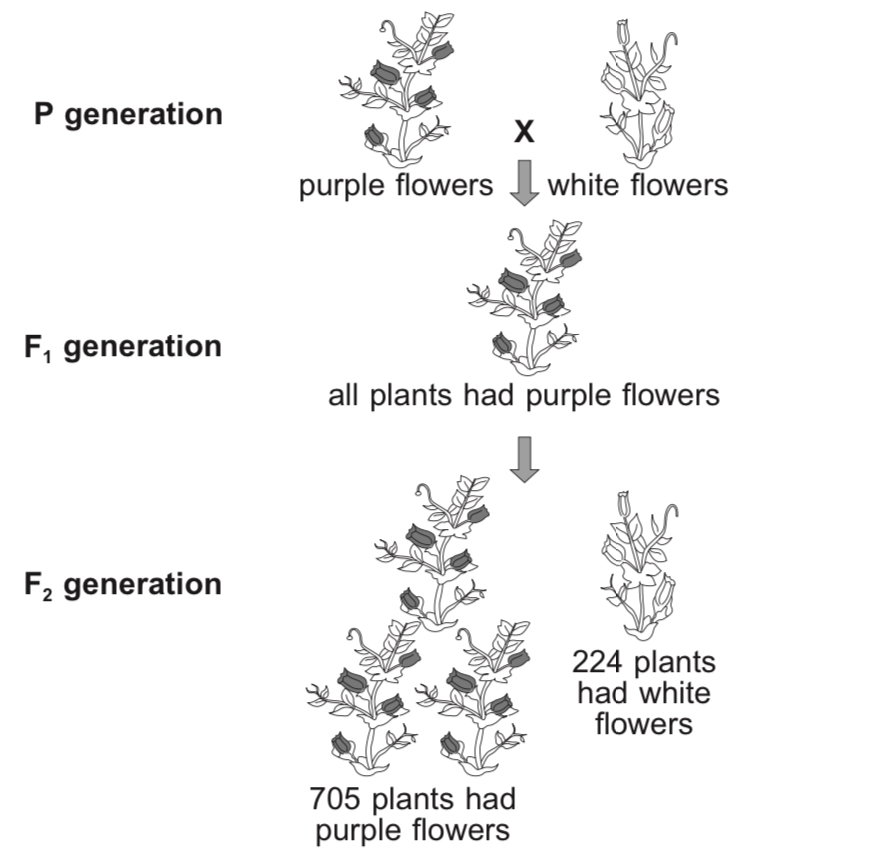
F1 generation did not possess %%intermediate traits%% between the two parents i.e. flowers produced by F1 generation were all as purple as flowers produced by the P generation purple-flowered plant, instead of being pale purple – an intermediate between the purple-flowered parent and white-flowered parent.
Self-pollination in F1 generation produced offspring (F2 generation) in which the white-flowered trait (not expressed in the F1 generation) resurfaced.
Mendel’s deductions:
(a) The heritable factor for white flowers did not disappear in the F1 generation since it was able to resurface in the F2 generation.
(b) Only the purple-flower factor affected flower colour in the F1 generation. He called the purple-flower trait %%dominant%% and the white-flower trait %%recessive%%.
Hereditary factors are responsible for transmission of characteristics from one generation to the next. These factors are now called %%genes%%.
Each characteristic is controlled by a %%pair of alleles%% (different forms of the same gene) in an organism. For example, flower colour in pea plants is controlled by an allele for purple flowers and an allele for white flowers. In other words, the gene for flower colour has two alleles: purple and white.
Each organism inherits one allele from the mother and one allele from the father during sexual reproduction. Each body cell of an organism contains two alleles for each trait.
If an organism has two different alleles, then the dominant allele will show its effect while the recessive allele will have no effect on the organism’s appearance.
Glossary of terms involved in genetics
- %%Chromosome%% – A chromosome is an organised structure of deoxyribonucleic acid (DNA) and protein that is found in the nuclei of cells. DNA contains genetic information used in the development and functioning of all organisms.
- %%Gene%% – A gene is a DNA segment located in a chromosome, which codes for a single unit of inheritance. The place on the chromosome where the gene is located is called the gene locus.
- %%Allele%% – Alleles are different versions of the same gene. They are located on the same gene locus in homologous chromosomes.
- %%Phenotype%% – An observable characteristic of an organism. It can be physical (appearance), behavioural or physiological. It depends on the genotype of the organism.
- %%Genotype%% – The genetic make-up of an organism. The genotype of an organism cannot be easily predicted from the phenotype (appearance) because of the existence of dominant and recessive alleles.
- %%Homozygous%% – Each organism inherits two alleles for a given characteristic, one from the mother and one from the father. An organism is said to be homozygous for a given trait when it contains two identical alleles for that trait.
- %%Heterozygous%% – An organism is said to be heterozygous for a given trait when it contains two different alleles for the characteristic.
- %%Dominant allele%% – A dominant allele is the allele that is fully expressed in the phenotype under both homozygous and heterozygous conditions.
- %%Recessive allele%% – A recessive allele is the allele that is only expressed in the phenotype under the homozygous condition. It is masked in the phenotype under heterozygous conditions.
Genetic Diagram:
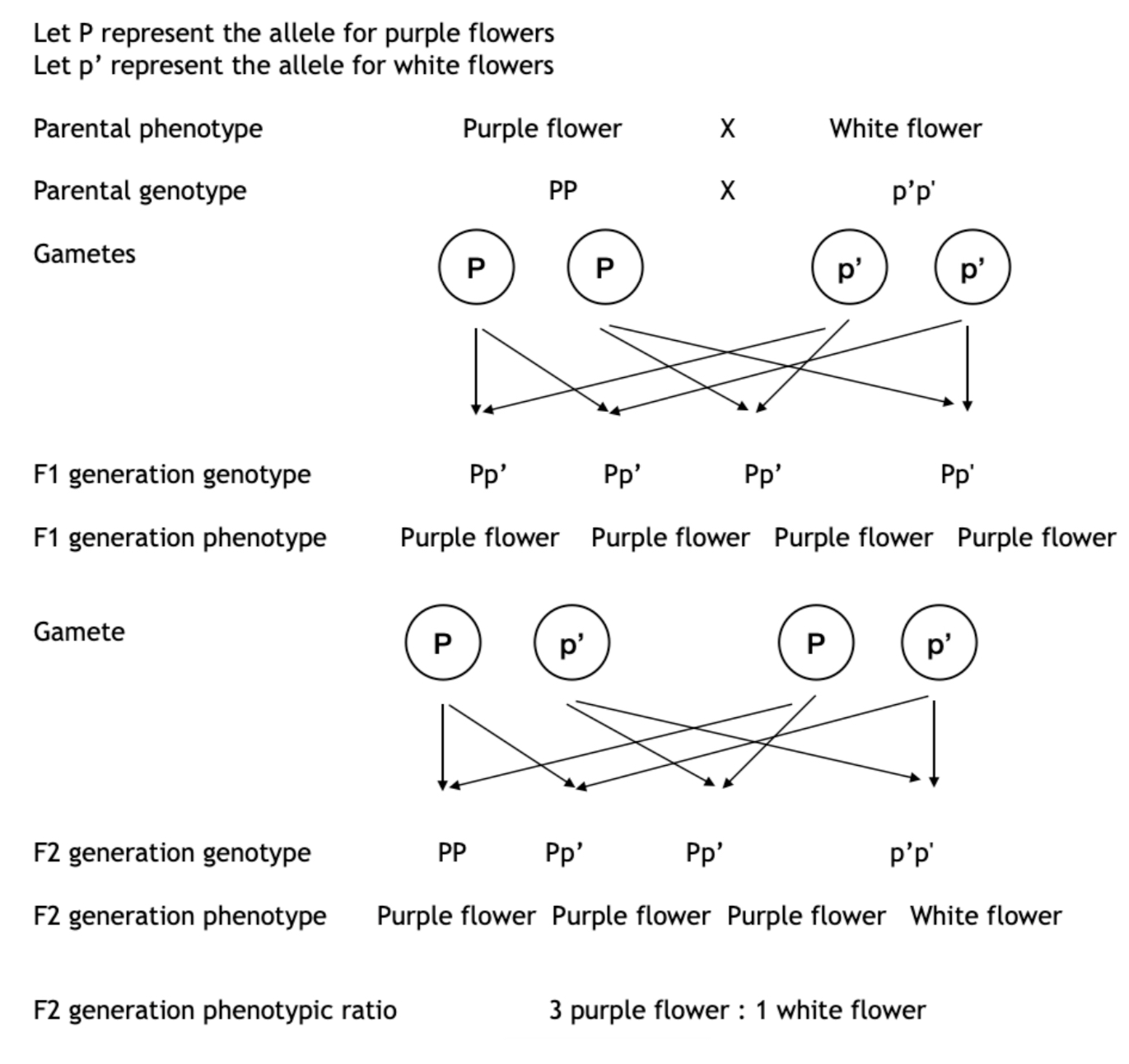
- 3 purple flower: 1 white flower is the expected ratios, but the actual observed ratio can be different especially when there are small numbers of progeny, because fertilization of the ova and sperms is a random event. Therefore the expected ratios are only based on chance and probabilities. With small number of offspring, the observed ratios often differ from expected ratios. But, with large number of offspring (large sample size), the observed ratios will be closer to expected ratios.
Variation:
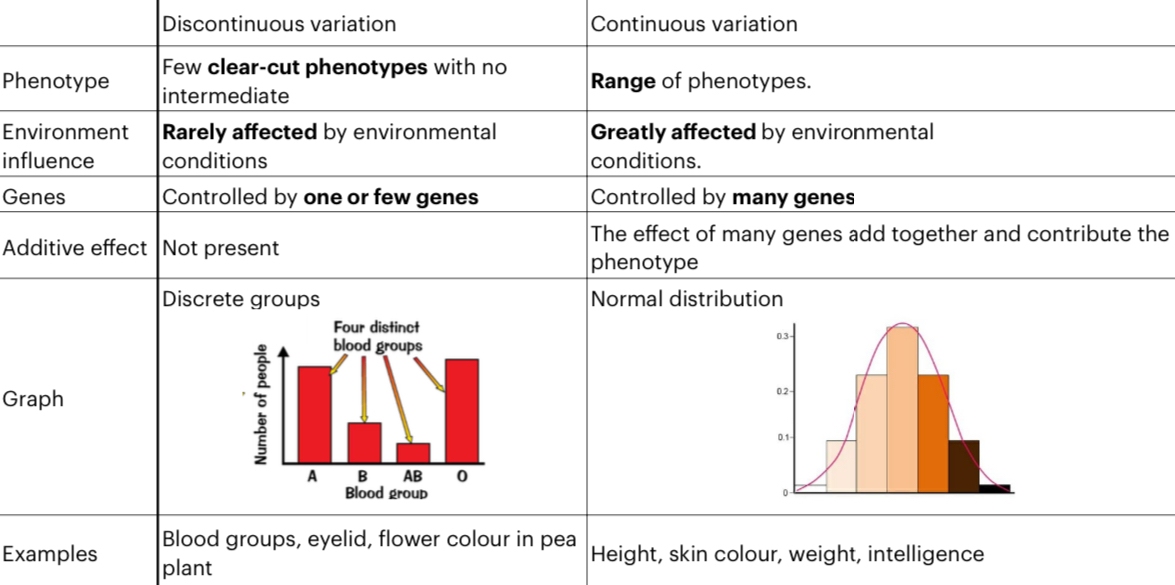
Dominance
%%Complete dominance%% is when the heterozygote has the same phenotype as the dominant homozygote. The recessive allele present in the heterozygote is masked by the dominant allele.
%%Co-dominance%% is when both alleles contribute equally to the phenotype.
An example would be the ABO blood typing system in humans. Human blood groups are determined by 3 alleles for 1 gene: IA, IB and IO.
IO is recessive to both IA and IB, while IA and IB are codominant when paired together.
The various combinations of the alleles and the resultant %%phenotypes%% are shown in the table below:
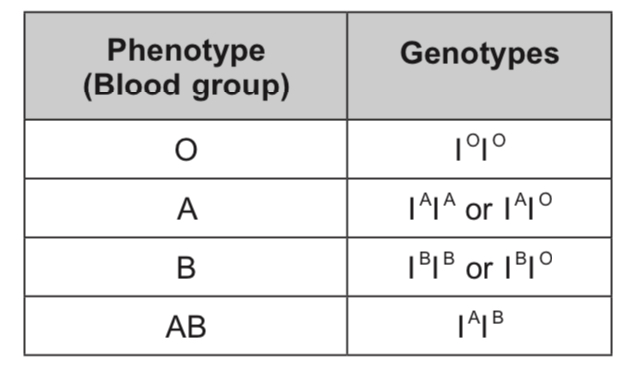
The gene for blood group codes for a protein present on the surface of red blood cells, called an %%antigen%%. The allele IA codes for antigen A, IB codes for antigen B, and no antigen is expressed for allele IO.
For IAIB %%genotype%%, both antigen A and antigen B are expressed since each of the alleles produces its own antigen. Both alleles contribute to the phenotype, which is blood group AB.
The gene for human blood groups is said to have multiple alleles since it exists in more than two alleles.
Sex Determination
A human cell has 23 pairs of chromosomes and the last pair is the %%sex chromosomes%%
In humans, sex is determined by sex chromosomes. Human sex chromosomes are the X chromosome and the Y chromosome.
X chromosome is much larger than the Y chromosome.
Human males have one X chromosome and one Y chromosome (XY genotype) while human females have two X chromosomes (XX genotype)
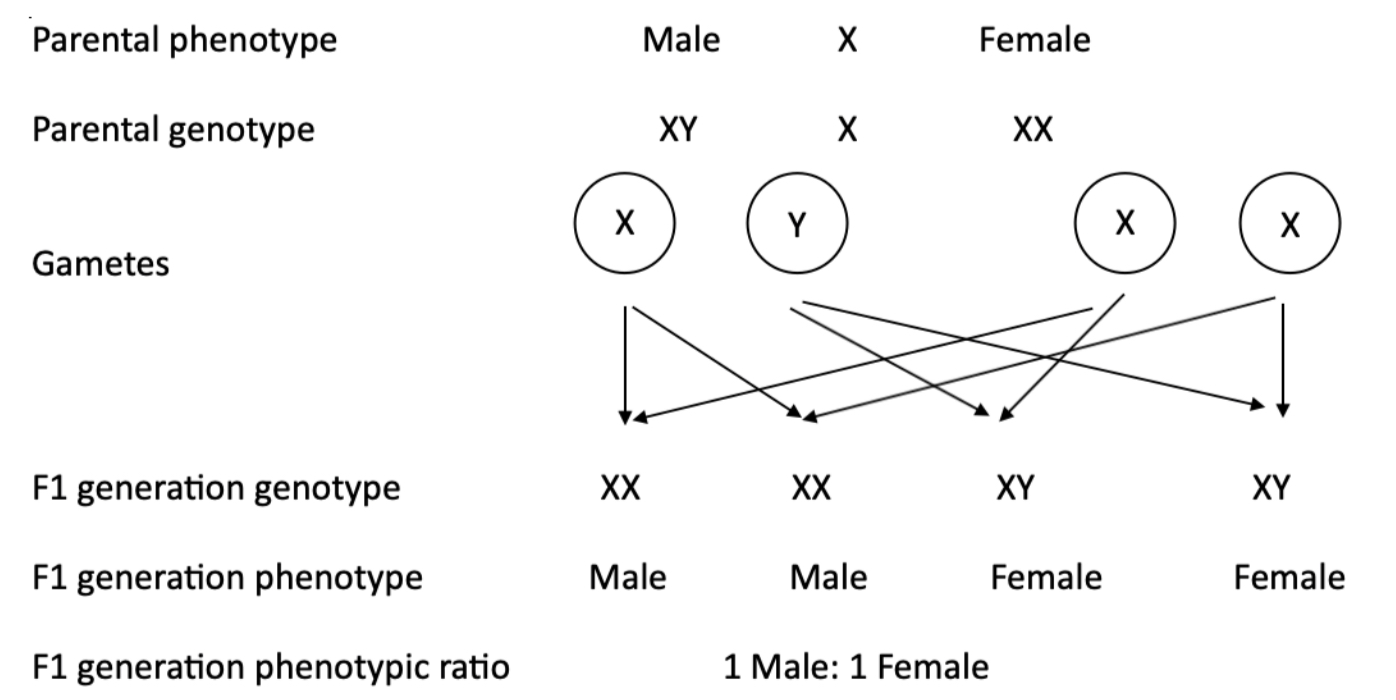
Mutation
- %%Mutation%% is a change in gene or chromosomal structure. Mutations that occur in gamete DNA can be passed down to the next generation.
- Mutations that occur in normal body cells (%%somatic mutations%%) are not passed on to the next generation. However, they are responsible for certain types of cancer.
- %%Spontaneous mutations%% can arise during the replication or repair of DNA. The %%DNA-replication%% mechanism in our cells normally has high fidelity, but occasional errors might occur.
- Mutations can also be caused by exposure to mutagens. %%Mutagens%% are physical or chemical agents that increase the rate of mutation. Examples of mutagens are ultraviolet radiation, X-rays, radioactive particles such as gamma rays, certain chemicals such as benzene, ethidium bromide and nitrous acid.
- Gene mutation increases the amount of genetic variation in the gene pool as it introduces new alleles. Some mutations can be favourable.
Gene mutation
- An example of a disease caused by gene mutation would be %%sickle-cell anaemia.%%
- Sickle-cell anaemia is a blood disorder where red blood cells possess a rigid, sickle shape when oxygen concentration in the blood is low.
- Normal red blood cells are flexible and can change their shape in order to pass through capillaries. Sickle-shaped red blood cells are not able to do so, %%blocking%% up arteries and failing to deliver blood to certain tissues, causing tissue damage.
- Sickle-cell disease is caused by a mutation in the gene for haemoglobin production. It causes a single amino acid in the normal haemoglobin chain to be replaced by another amino acid. This causes a change in the 3-dimensional shape of the haemoglobin molecule. HbS molecules clump together under low oxygen concentration, causing red blood cells to become sickle-shaped.
Chromosome mutation
- %%Down syndrome%% is a condition caused by a chromosome mutation during %%meiosis%% (gamete production). It results in mental retardation, and heart and respiratory defects.
- The zygote inherits 3 copies of chromosome 21 instead of 2, and this mutation is present in all body cells due to %%mitosis%% during zygote development. Each body cell of the afflicted individual contains 47 chromosomes instead of the usual 46.
- This chromosome mutation is far more likely to occur during ovum production than during sperm production
- Women above 30 have a higher risk of carrying babies with Down syndrome. %%Fetal testing%% is recommended for older mothers to check for Down syndrome in the embryo.
Natural Selection, Artificial Selection, Genetic Engineering:
